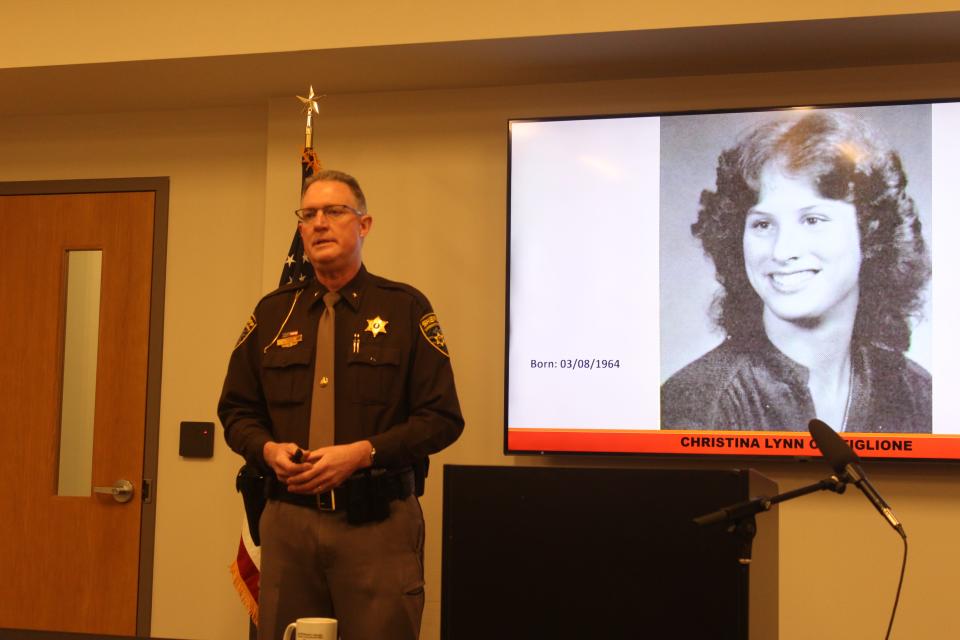DNA leads to ID of suspect in 40-year-old homicide case, Sheriff's Office says

HOWELL — Police say they have identified a suspect in the 40-year-old cold case murder of Christina Castiglione by using genealogical DNA comparisons.
The Livingston County Sheriff’s Office Cold Case Team conducted a press conference Wednesday morning to announce the breakthrough that led them to Charles David Shaw.
Shaw, who lived in Livonia less than 5 miles from where Castiglione went missing, died in November 1983 of accidental sexual asphyxiation, according to Detective Sgt. Matt Young, who contacted the Wayne County Medical Examiner's Office when his name came up as a suspect.
"When there's a homicide, there's normally some sort of a connection between the victim and the suspect and, in this case, there was none. That's one of the reasons that this was 40 years in the making. There was no tips. There was no evidence. There was no indication that would lead us to Charles Shaw," Livingston County Sheriff Mike Murphy said.
On March 21, 1983, 19-year-old Christina Castiglione was reported missing by her mother in Redford Township. On March 29, 1983, the Livingston County Sheriff's Office found Castiglione's body in the Oak Grove State Game Area at the corner of Faussett and Fisher Roads in Livingston County's Deerfield Township after a tip.

Castiglione was partially clothed and her body was in a remote wooded area. Detectives found evidence that Castiglione had been strangled to death and sexually assaulted.
During the autopsy, the medical examiner found male DNA that was collected and preserved.
“The work that was done back in 1983 to preserve the evidence, to process the scene, was an outstanding effort by everybody that was at the scene, detectives as well as the responding deputies,” Murphy said.
The samples were later entered into CODIS by the Michigan State Police Crime Lab in the early 2000s, but a suspect was not identified at that time.
The Livingston County Sheriff's Office Cold Case Team, Young, FBI retiree Bob Getschman, retired Mackinac Island police chief Bill Lenaghan, retired Livingston County detective Edwin Moore and detective Lt. Jim Lynch, eventually began looking at the case, along with several others.
In March 2022, the Sheriff's Office applied for and received grant funding through Season of Justice to conduct advanced DNA testing on the samples taken in 1983. Season of Justice is a nonprofit organization dedicated to funding DNA testing on unsolved cold case homicides, the Sheriff's Office said in a press release.
In May 2022, DNA evidence from the case was sent to Othram Inc., a private forensic laboratory in Texas. Othram scientists used "forensic-grade genome sequencing" to develop a comprehensive genealogical profile from the DNA of the unknown suspect.
Young said about 10 to 15 years ago the process cost about $100,000 and the county couldn't afford to do it, but the cost has come down significantly and the grant allowed them to go forward.
Othram's in-house genealogical team used the genealogical profile to produce leads. Othram returned the leads to the Livingston County Cold Case Team, which used the leads to continue following up on the Castiglione murder.

The investigation led to the identification of Shaw. His identification was confirmed by three separate familial DNA comparison tests.
"They were able to locate single hits within the DNA genealogy sites that came back to a living uncle of the suspect, and then we were able to build a family tree from that uncle to where we are today," Young said. "We did learn that, based on the profile of the suspect, Charles Shaw, that he was likely a nephew of the uncle that shared the same chromosome."
Young said they identified other nephews who didn't match the evidence, so that left them with two possibilities: a brother or son of the suspect.
"We sought out a living brother and a living son of the suspect and obtained target samples from the two of them. Those target samples were also analyzed by Othram and they came back with 100% match as brother/brother and father/son relationship," Young said.
Young said Shaw's brother was shocked by the news.
"He had no idea. He was a little bit older than Charles Shaw, so he was in the military when a lot of this was going on in Charles' life, so we wasn't around to witness all of it first hand," Young said.
Based on information received from Shaw's family, the Sheriff's Office said, he was a sex addict with a disturbing life who struggled with mental illness and his gender identity.
"Charles Shaw had several interactions with law enforcement beginning at a young age. One such interaction resulted in his arrest in 1981 for the attempted abduction of a woman in the Fowlerville McDonald's parking lot," the release noted.
In 1973, Shaw was arrested by the Livonia Police Department on a breaking-and-entering charge. In 1977, he was arrested by the LPD on a drug possession charge. In 1981, he was sentenced to two weeks in jail and probation for the Fowlerville incident, according to Young. And in 1982, he was arrested for larceny of women's shoes from a Kmart.
Castiglione lived with her mother and father in Redford. She graduated from Redford Union High School and was active in sports, the release said. She was not married but had a steady boyfriend. She was employed by the Detroit Edison Company as a clerk in the research department and had recently contacted an Army recruiter.
"The cooperation of the Shaw family during the investigation was paramount to identifying Charles Shaw as the person responsible for the homicide of Christina Castiglione," the release said. "We are hopeful that the surviving family members of Christina Castiglione, along with victims and families of other violent unsolved crimes who have been awaiting justice for decades, experience closure as genealogical DNA continues to help law enforcement advance efforts to achieve justice for victims."
Other unsolved murders
"The hope is that we end up solving some other (murders). They are not giving up. We're not done. There are other cold cases out there, but I couldn't be happier with the work that was done," Murphy said.
Among the unsolved homicides in Livingston County are:
Kimberly Louiselle, 16, was last seen near 8 Mile and Merriman roads in Livonia on March 20, 1982. Nearly three weeks later, her body was found in a thicket in the Island Lake Recreation Area in Green Oak Township by a couple hiking in the park.
Paige Renkoski, of Okemos, was last seen talking to a man standing between her car and a maroon minivan on May 24, 1990, on the shoulder of Interstate 96, a quarter-mile east of the Fowlerville exit. Although her body has never been found, police have ruled the case a homicide.
Michael Painter was a school bus driver walking through a swampy area of Oceola Township near Curdy Road, east of Eager Road. His body was found on March 7, 1975. The 18-year-old Dearborn Heights man's body had been there less than 24 hours. He had been shot multiple times in the head.
Anthony Holz was a 27-year-old man who arrived home on May 23, 1980, to find intruders had tied up his girlfriend, who had bruises and cuts all over her body. He was gunned down as he ran from his home on Lovejoy Road, on the northern border of Livingston County. His girlfriend, also dead, had been raped and beaten. Police at the time said it was drug related.
Jerry Sivec was a 47-year-old Detroit man reported missing by friends in August 1972 when he failed to report to work. More than two months later, his decomposed body was found near Pleasant Valley and Larkin roads, 3 miles east of Brighton. He had died of a single gunshot wound to the head.
Anthony (Nikki) Nicholas was a Detroit resident whose body was found in an abandoned farmhouse in Green Oak Township in February 2003. Nicholas, who was transgender, had supported herself as a female impersonator in several metro Detroit bars. Nicholas was last seen Feb. 15, 2003, when she was going to a party somewhere between Detroit and Ann Arbor. She died from a gunshot wound.
Livingston Daily reporter Patricia Alvord can be reached at palvord@livingstondaily.com.
This article originally appeared on Livingston Daily: Cold case team finds suspect in 1983 murder through DNA testing

 money
money 